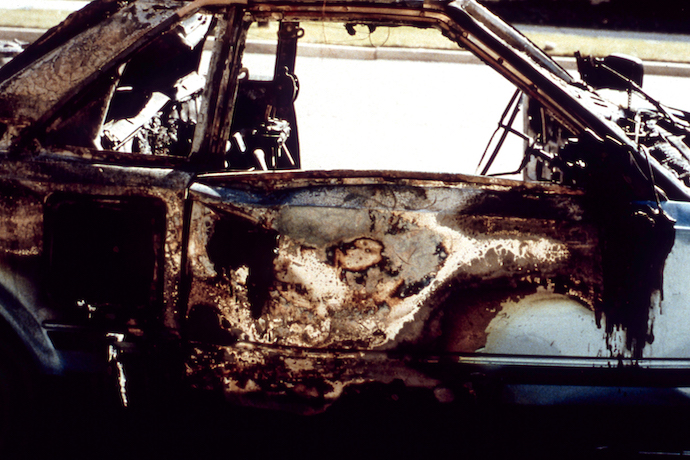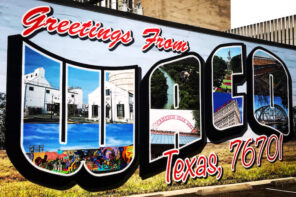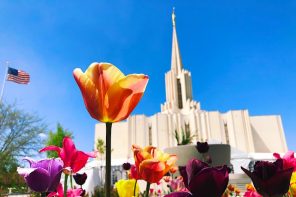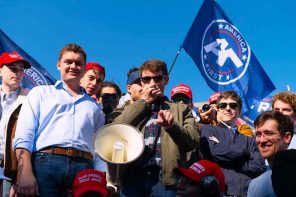Note on spoilers, etc: This essay covers the broad outlines of the Mark Hofmann forgery and murder case, which will be highlighted in the new Netflix documentary, though it does not detail any of the documentary’s new discoveries. Recaps for each of the three episodes will appear later this week, on March 3, 4, and 5.
On October 15, 1985, the city of Salt Lake City, Utah, was shaken to its core. That morning, a fatal bomb exploded at the office of businessman Steven Christensen; that afternoon, another bomb claimed the life of Kathy Sheets, the wife of one of Christensen’s colleagues, at her suburban home. Many assumed the deaths were related to an investment deal gone sour.
However, there was another link that seemed more provocative and immediately caught the national spotlight: the intended victims had also been involved in the purchase of a controversial historical letter several years previous that threatened to undercut the historical origins of the Church of Jesus Christ of Latter-day Saints.
Things escalated the next day, October 16, when a third bomb detonated in the car of Mark Hofmann, the documents dealer who had found and facilitated the letter’s sale, confirming the murders had more to do with Mormonism than money. Hofmann survived with critical injuries from the explosion, only to later become the prime suspect behind all three devices.
Then, over the course of the next year, tedious investigations concluded that not only was Hofmann a cold-blooded killer, but also the most successful forger in American history, having sold dozens of fake documents to a number of institutions for a total of over a million dollars. Hofmann’s is a story that is so enthralling that it would capture the nation’s admiration were it not for the outright fraud and tragic reality that it resulted in lost lives, broken homes, and devastated communities.
This Wednesday, March 3, Netflix will release Murder Among the Mormons, a three-part documentary series that narrates the events surrounding Hofmann’s rise and fall, his bombs, and the investigative work that brought him to justice. Directed by Tyler Measom and Jared Hess, it’s a fast-paced production with an impressive amount of video coverage from the 1980s as well as substantial interviews with many key figures, interspersed with dramatic reenactments of several significant moments from the tale.
The series builds on America’s fascination with true crime documentaries, a genre that has exploded in recent years, especially on binging platforms like Netflix. Hofmann, then, will easily fit into this established pattern, the genius criminal whose mind captivates national attention.
But for those in the Latter-day Saint community, the Hofmann forgeries and bombings had longer legacies that transcend what they’ll see on the screen. The crisis also raises questions concerning spiritual belief, religious scholarship, and faithful belonging in a modern era.
Bolder and bolder forgeries
The Church of Jesus Christ of Latter-day Saints celebrated its sesquicentennial in 1980, the year of Mark Hofmann’s first forgery. After spending much of its first century as a cultural pariah, the faith had witnessed a surprising rise in popularity over the previous few decades. Church leaders were featured on the covers of national magazines in a positive light, church initiatives were praised by national politicians, and church members like Donny and Marie Osmond captured the nation’s heart. Indeed, the 1970s were a period of optimism within the faith, fueled by warm feelings at home and growth across the globe, and punctuated in 1978 with the long-awaited end to a racial restriction that was one of the last remaining, and painful, legacies from the church’s more parochial era.
There were also positive developments within the faith’s nascent intellectual community. A host of Mormon scholars took advantage of a newfound openness from church leadership after an academic was made the Church Historian in 1972, the first non-ecclesiastical leader to hold the position. The church archives granted increasingly generous access to previously restricted documents, which resulted in revisionist, and at times challenging, narratives of the faith’s origins. After 150 years of defending the past and rejecting dissenting interpretations, there was now movement for a more nuanced, complicated, and honest assessment. Participants later referred to this period as Camelot.
It was in this context that Hofmann, still an undergraduate student, created his first forgery, a transcript that Joseph Smith had supposedly copied from the gold plates themselves. Upon examination, history experts declared it the earliest holograph from the prophet, and church leaders posited it as a clear vindication of the Book of Mormon’s truth claims. Hofmann, however, who by that time had lost his faith in the tradition, secretly took immense glee at fooling academics and apostles alike.
The following years featured a stream of more documents, each seemingly more exciting than the last, nearly all originating from the young dealer, who had now given up schooling to focus on his new trade full-time. If the sheer amount of these documents all appearing at once seems, in hindsight, an obvious red flag, at the moment it felt exhilarating for all involved. The faith’s sesquicentennial had seemed to invite a flood that matched the tradition’s optimism, as well as the culture of excess in 1980s America.
But Hofmann meticulously and slowly evolved in his choices regarding what his forged documents would say. While his first forgery promoted traditional faith, his later texts became increasingly unorthodox. In 1981, for instance, he presented an 1844 blessing from Joseph Smith that delegated his son, Joseph Smith III, the faith’s true successor, rather than Brigham Young. Other documents similarly challenged traditional narratives, adding fuel to a growing fire over how to handle the faith’s past.
No document caused as great a storm as the so-called “Salamander Letter,” which Hofmann sold in early 1984. The scandalous document was supposedly written by Martin Harris, one of Smith’s earliest converts and a witness to the Book of Mormon. It offered an alternate origin to the gold plates by directly tethering the artifact to the folk magic culture of its era, featuring an angel who transformed into a “white salamander” who guarded the sacred record. Historians had been emphasizing the supernatural culture of early America, something official church narratives continued to ignore, but Hofmann’s forgery made the connection explicit. Though LDS leaders chose not to purchase the document itself, Steven Christensen bought it on behalf of the church and donated it to its archives.
Even as Hofmann’s forgeries became more daring, so too did his problems. He believed he was on the verge of even larger sales—his forgery of an original “Oath of a Freeman,” if authenticated, would have sold for $1.5 million—but his vision exceeded his grasp, and soon creditors and dealers were hot on his trail. His promise to produce the “McLellin Papers,” documents from an early Mormon apostle who had left the faith, was supposed to be both a boon to his wallet and another strike against the church. But he struggled to produce a project on such a large scale.
When all seemed lost, Hofmann made the deadly decision to plant bombs in order to divert attention and buy more time. Instead, the deaths brought his half-decade career to a deadly halt, and insurmountable trauma to several families.
Murder Among the Mormons spends most of its time on the resulting investigation, including the mistakes Hofmann made that led to police suspicion and the brilliant work by forensic investigators to uncover his forgeries. Hofmann was arrested in January 1986, pled guilty in January 1987, and sentenced to a life in prison. But even if the legal story climaxed surprisingly quickly, significant legacies remained long afterward.
Pressure mounts from all sides
Mark Hofmann didn’t create the wars over Mormon origins, but he certainly escalated them. Historians who’d been working to revise traditional narratives, including the folk magic context of antebellum America, were now caught on the defensive for using documents now exposed as having been forged by a notorious killer; traditional apologists, eager to defend the faith, felt bolstered in their opposition to what they saw as creeping revisionist corruption.
The scholarly debates that ensued over the next decade were hotly contested, and often personal, as the stakes over historical research never seemed so high. In September 1993, six prominent intellectuals were excommunicated, followed by several others in the proceeding years. The entire community seemed at battle, the lingering embers of the Hofmann fire.
Ironically, two of the most outspoken critics of the LDS tradition, Jerald and Sandra Tanner, were also some of the first to openly wonder in 1984 whether the “Salamander Letter” had been forged. After proven correct, they now latched on to a new line of attack: they were more prophetic than the LDS prophets who were duped by a conman. Ever since, disillusioned members have cited the Hofmann episode as an example of the leaders’ fallibility and yet another cause for weakened faith.
Negative press also fed into a growing national skepticism concerning the LDS church in general. After enjoying several decades of warm feelings, climaxing in the sesquicentennial, the 1980s featured increased scrutiny. In evangelical circles, a resurgent fixation on “cults” placed the Mormons in a group of undesirable sects that failed to meet orthodox standards; on the eve of 1983, the anti-Mormon film The God Makers debuted before 4,000 Christians in Southern California, and quickly screened across the rest of the nation. In the political sphere, the church’s staunch opposition to the ERA resulted in tremendous backlash from progressive communities; their excommunication of Sonia Johnson, a public proponent of the amendment, received national attention. Mormonism faced new pressure from all sides.
The Hofmann story, then, fed into this growing trajectory of exoticizing the faith tradition just after it seemed to be on the verge of cultural assimilation.
Ironically, the episode also fit into the larger story of fears over religious frauds and conmen who were discovered in many religious traditions during the decade, including Jimmy Swaggart and Jim Bakker. The decade that began with optimism had quickly and dramatically closed with disillusion.
Tasked with handling this shifting terrain was Gordon B. Hinkley, a counselor in the First Presidency, Mormonism’s highest governing body. The other two members of the presidency, including the prophet, Spencer W. Kimball, were both incapacitated due to health, leaving Hinckley in charge. Yet his background in media made him uniquely positioned for the crisis. Though inextricably linked to Hofmann through his role facilitating a number of document purchases, he also had an eye to the future, envisioning a church that was much more media-savvy and tethered to the modern age. His quick work helped dissipate attention and avoid long-lasting repercussions.
A decade after the bombing, in 1995, Hinckley became the church’s fifteenth president. His thirteen years at the head of the faith are now remembered for the great strides taken to further court the national spotlight and earn cultural admiration, reversing the trends that surrounded the Hoffman episode. Indeed, managing the Hofmann crisis taught important lessons that in many ways shaped his governing philosophy.
The deadly explosions that rocked the Mormon community in 1985, and the drama that surrounded it, were part of a larger transition both within the faith and the nation. Mormon historians learned to be more careful when encountering new documents that appeared too good to be true, even as they continued their quest to offer a revisionist narrative of the faith. Eventually, church leaders learned to take a position toward this historical work that was less oppositional and more accommodating, resulting in a more sustained and responsible dialogue between the groups.
Meanwhile, after the tumultuous 1980s, the LDS tradition was able to regain acceptance from an evangelical community that had itself faced a decade of crises, enabling the two groups to better collaborate in the cultural coalition known as the Religious Right.
Addressing questions of faith, skepticism, and authenticity within a modern age is a challenge for all faiths, but none more so than America’s largest homegrown religion, the one founded by an uncovered scriptural record, yet nearly undone by skillfully forged texts.





